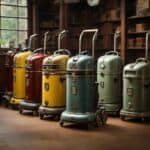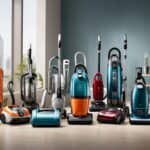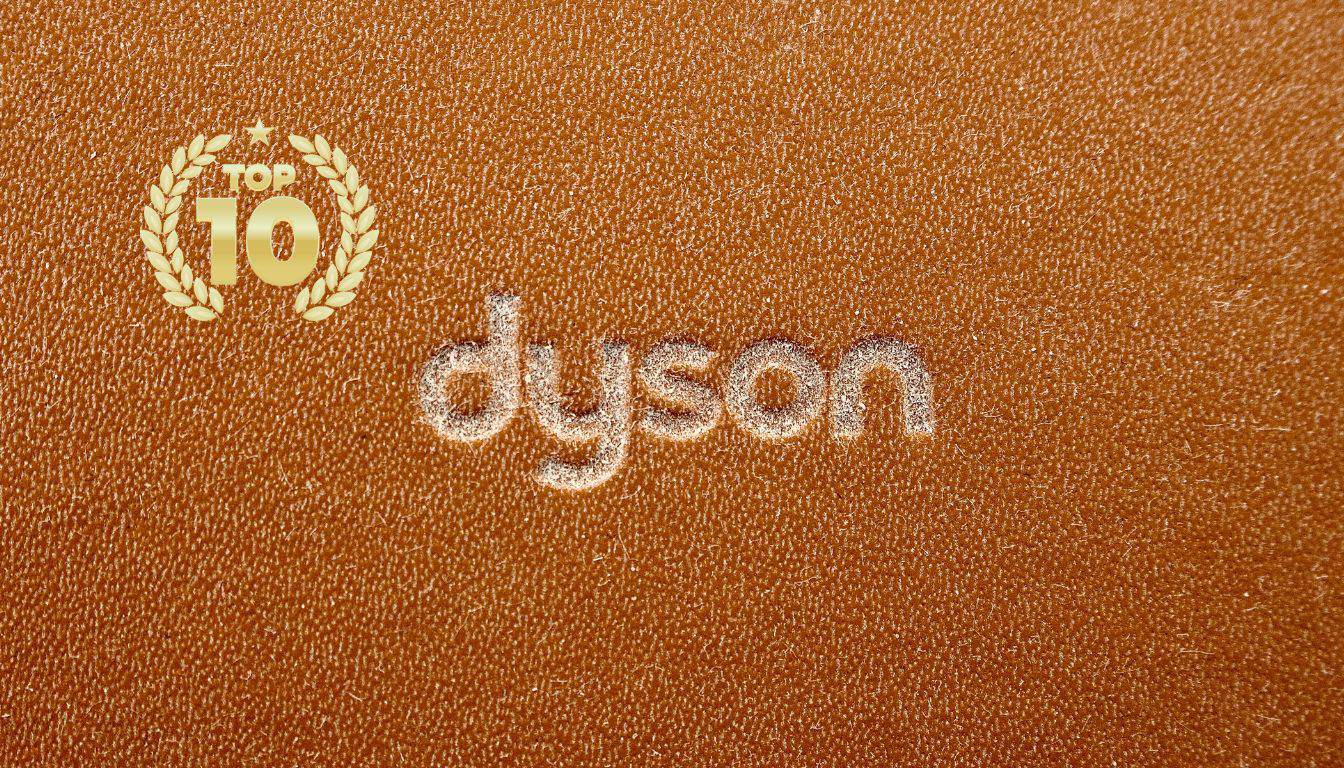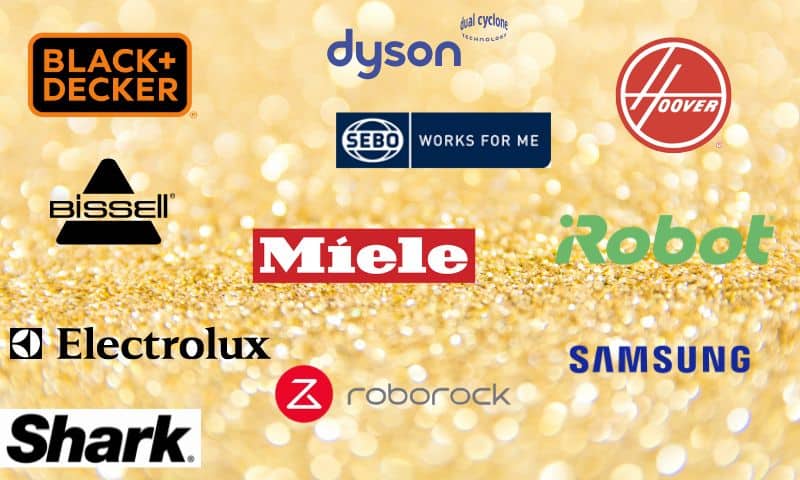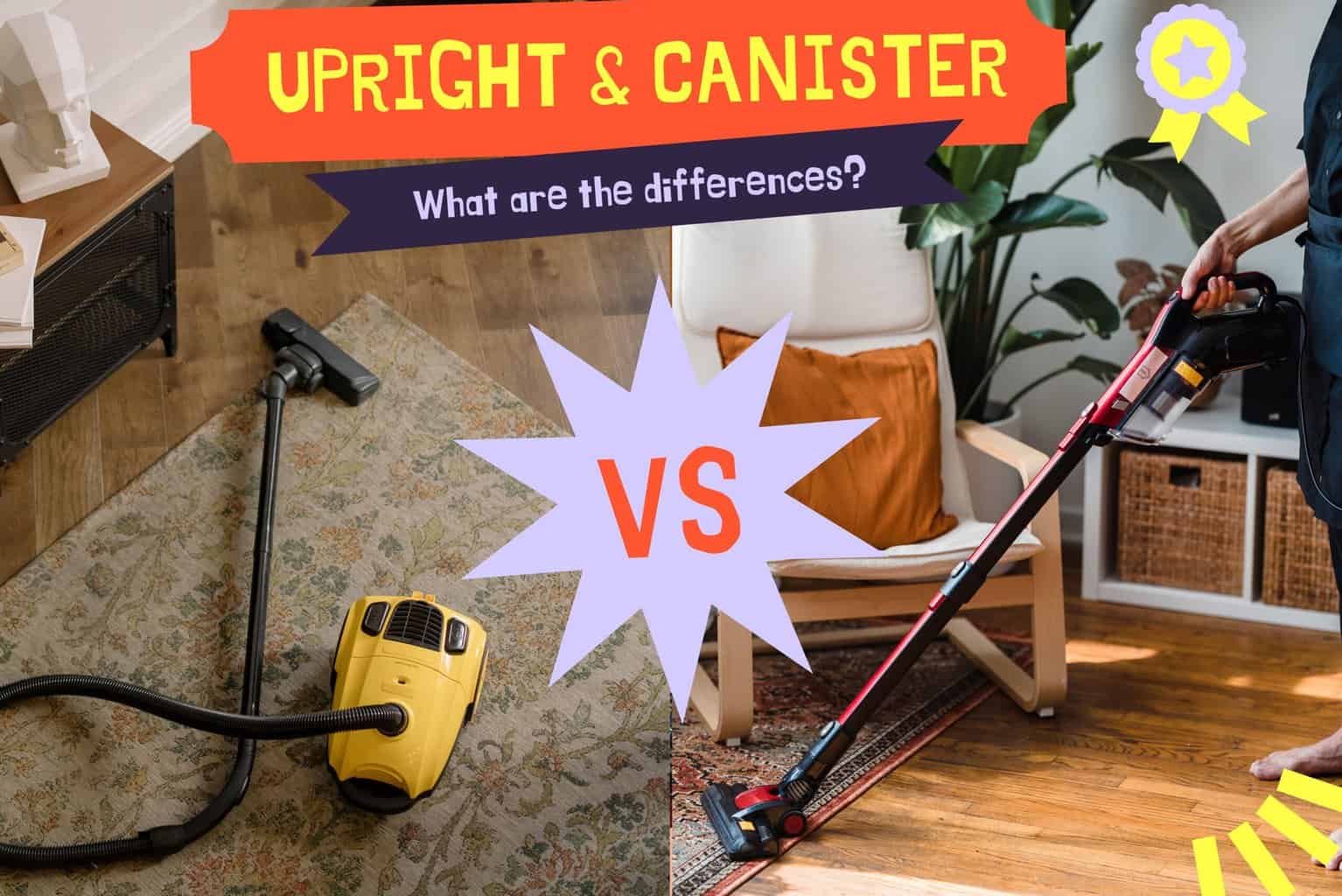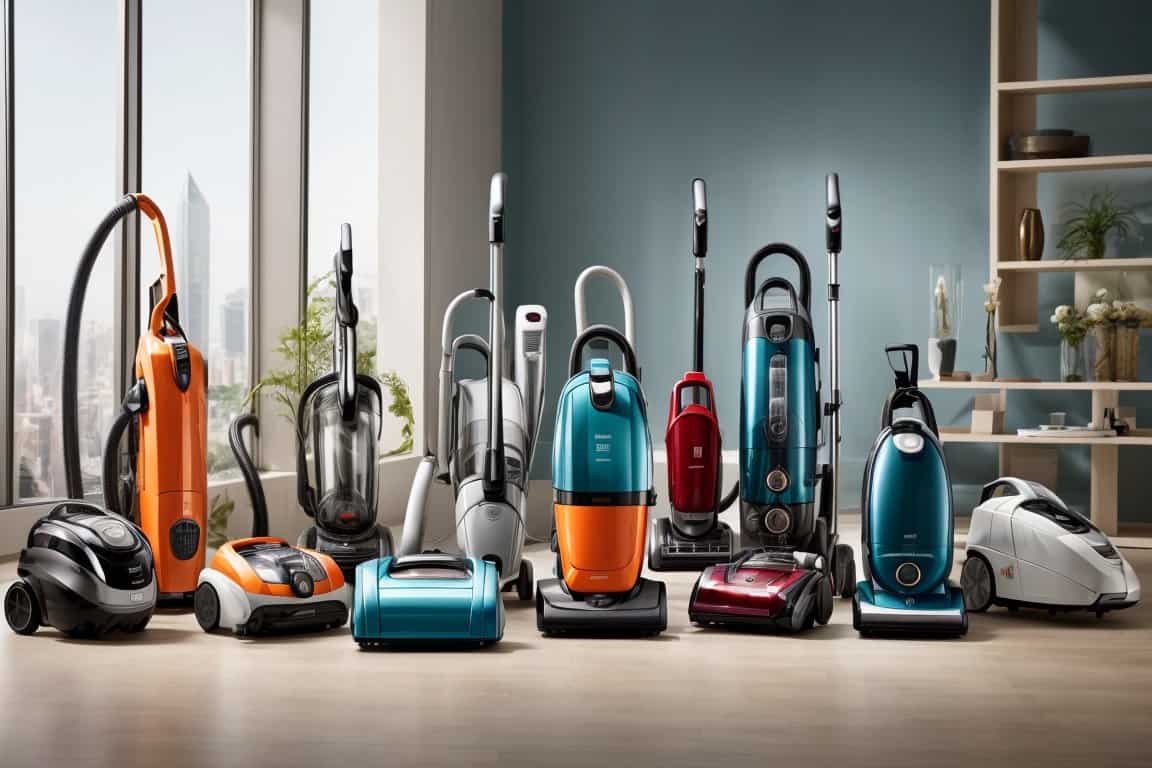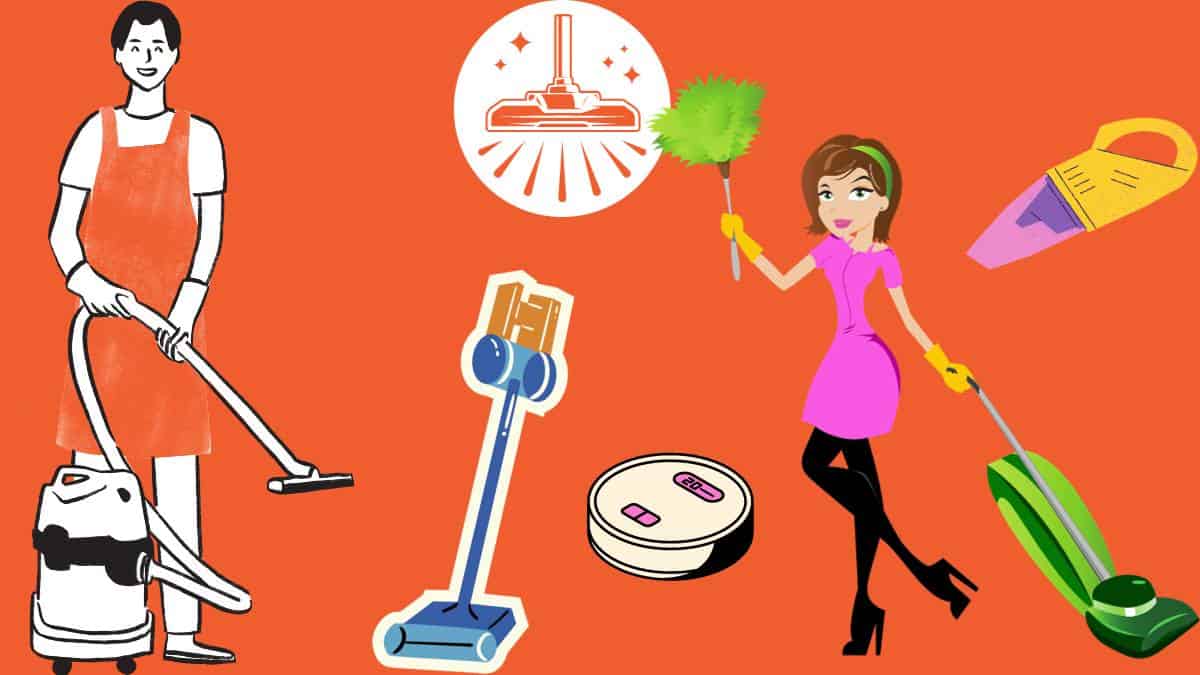
Understanding the Different Types of Vacuum Cleaners
When it comes to picking the right vacuum cleaner for your cleaning needs, the first thing to consider is the type of vacuum cleaner you require. There are five main types of vacuum cleaners currently on the market: upright, canister, stick, handheld, and robotic. Each type has its unique features, pros, and cons that make it suitable for different cleaning tasks.
Upright Vacuum Cleaners
Upright vacuum cleaners are the most common type of vacuum cleaner used in households. They are powerful and efficient, with a motorized brush that works well for cleaning carpets. Upright vacuums are also relatively easy to store and maintain. They are typically heavier and bulkier than other types of vacuum cleaners, making them less suitable for cleaning tight spaces or stairs.
Canister Vacuum Cleaners
Canister vacuum cleaners are versatile and powerful, with a design that separates the motor and dustbin from the cleaning head via a hose. They are generally more lightweight and maneuverable than upright vacuums, making them ideal for cleaning stairs and hard-to-reach areas. Canister vacuums may not be as effective on carpets as upright vacuums.
Stick Vacuum Cleaners
Stick vacuum cleaners are lightweight and compact, making them an excellent option for quick and easy cleanups. With their slender design, they can easily reach tight spaces. Stick vacuums are typically cordless, which makes them very convenient to use. However, they are less powerful and may require more battery charging time than other types of vacuum cleaners.
Handheld Vacuum Cleaners
Handheld vacuum cleaners are ideal for cleaning small messes and tight spaces, such as car interiors and upholstery. They are portable and lightweight, making them easy to use for spot-cleaning. Handheld vacuums are less potent than other types but are perfect for quick cleanups and for tackling hard-to-reach areas.
Robotic Vacuum Cleaners
Robotic vacuum cleaners are the most convenient type of vacuum cleaners available today. They use sensors and built-in cameras to navigate and clean your home automatically, making them perfect for busy households. Robotic vacuums are smaller and less potent than other types. Still, they can often return to their charging docks when their battery is low, making them a convenient option for daily cleaning.
Bagged vs. Bagless Vacuum Cleaners: Which is Right for You?
When shopping for a vacuum cleaner, one of the most significant decisions you’ll make is whether to go for a bagged or bagless model. Both options have their pros and cons, and the choice ultimately comes down to personal preference and cleaning requirements.

Bagged Vacuum Cleaners
Bagged vacuum cleaners use disposable bags to collect dirt, dust, and debris. When the bag fills up, you replace it with a new one. Here are some advantages and disadvantages of using a bagged vacuum cleaner:
| Pros | Cons |
| Less mess when emptying Effective filtration Longer-lasting bags mean fewer replacements | Additional cost for buying replacement bags May reduce suction as the bag fills up Less sustainable than bagless options |
If you suffer from allergies, a bagged vacuum cleaner with a HEPA filter can be a great option. The bags seal tightly, trapping all the dust and debris inside and preventing it from releasing back into the air. Additionally, bagged vacuum cleaners tend to have more extended-lasting bags, meaning less frequent bag replacements.
Bagless Vacuum Cleaners
Bagless vacuum cleaners use removable canisters to collect dirt and debris. Once the canister fills up, you empty it into the trash and reinstall it in the vacuum. Here are some advantages and disadvantages of using a bagless vacuum cleaner:
| Pros | Cons |
| No need to buy replacement bags Greater suction power Easy to see when it needs emptying | Messier when emptying May release dust and debris back into the air Filters need regular cleaning or replacement |
Bagless vacuum cleaners tend to have more substantial suction power than their bagged counterparts since there is no loss of suction as the bag fills up. They are also more environmentally friendly since they do not need replacement bags, reducing the overall waste created by the vacuum cleaner. However, it’s worth noting that bagless vacuum cleaners can be messier to empty than bagged ones, and you may need to clean the filters regularly to maintain optimal performance.
In conclusion, both bagged and bagless vacuum cleaners have their benefits and drawbacks. The choice ultimately comes down to your cleaning needs and preferences. Consider the cost of replacement bags, the frequency of bag replacements, and your preferences for mess-free cleaning when making your decision.
Corded vs. Cordless Vacuum Cleaners: Which is the Better Choice?
When it comes to choosing a vacuum cleaner, one of the critical decisions to make is whether to opt for a corded or cordless model. Both have their advantages and disadvantages, so it’s essential to weigh them carefully to determine which type is the best fit for your cleaning needs.
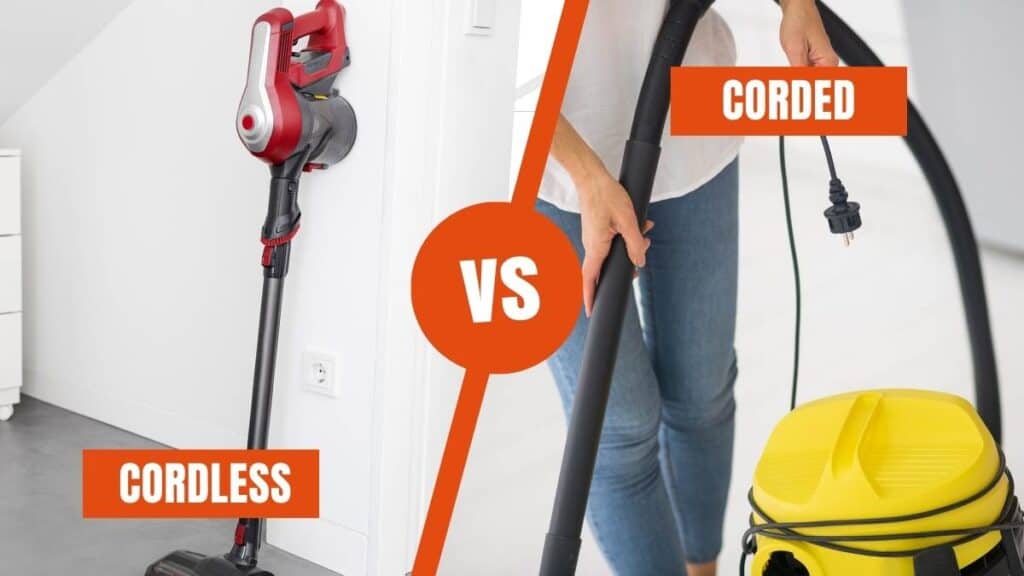
Corded Vacuum Cleaners
Corded vacuum cleaners, as the name implies, need to be plugged into a power outlet to operate. They tend to be more powerful than cordless models and are especially effective for deep cleaning carpets. They also typically have larger dust cups and longer power cords, making them ideal for cleaning large areas.
However, corded vacuums have some downsides. They can be cumbersome to move around, and the power cord can be a tripping hazard if not managed correctly. Additionally, they don’t offer the same freedom of movement as cordless models, limiting their use to areas near a power outlet.
Cordless Vacuum Cleaners
Cordless vacuum cleaners operate using rechargeable batteries, eliminating the need for a power cord and giving you greater flexibility to move around while cleaning. They tend to be lightweight and easy to maneuver, making them ideal for cleaning stairs, upholstery, and hard-to-reach places.
On the downside, cordless vacuums typically have less suction power than corded models and shorter battery life, leading to decreased cleaning efficiency and the need for more frequent recharging. Additionally, they may have smaller dust cups, requiring more frequent emptying.
| Feature | Corded | Cordless |
| Suction Power | High | Medium to Low |
| Battery Life | N/A | Short to Medium |
| Dust Cup Capacity | Large | Small to Medium |
| Weight | Heavy | Light |
| Maneuverability | Low | High |
Overall, the choice between corded and cordless vacuum cleaners depends on your cleaning needs, your living space, and your personal preferences. Suppose you have a large home with carpets and need maximum suction power and cleaning efficiency. In that case, a corded vacuum cleaner may be the way to go. But suppose you have a smaller space and need a vacuum cleaner that is easy to maneuver and offers greater flexibility. In that case, a cordless model might be the better choice.
Must-Have Features in a Vacuum Cleaner
When it comes to choosing a vacuum cleaner, there are several features that you should consider to ensure optimal cleaning performance and versatility. Let’s take a look at some essential features:
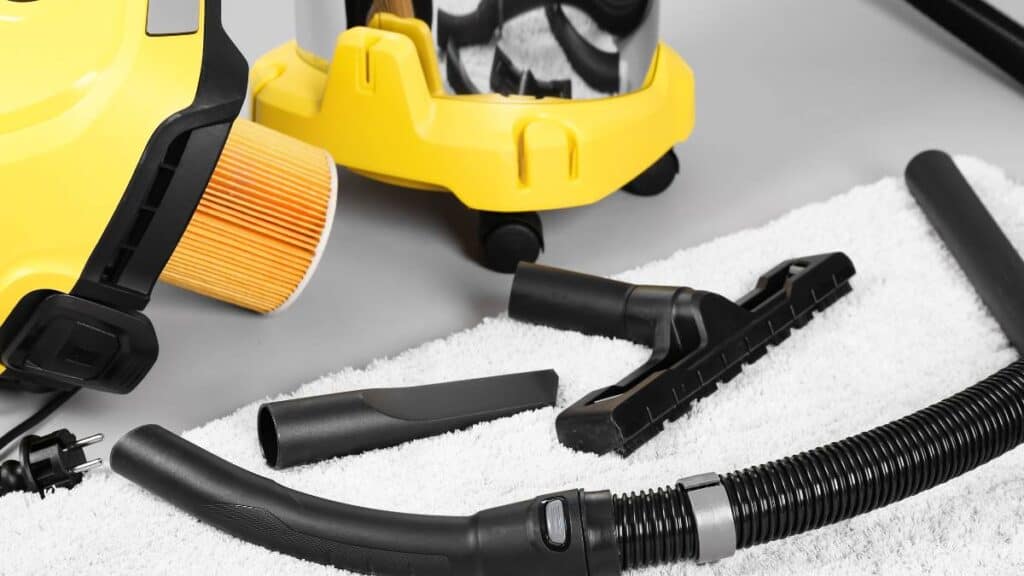
Suction Power and Filtration Systems
Suction power is a crucial aspect of any vacuum cleaner. It determines how efficiently the machine can pick up dirt and debris from your floors and carpets. Look for models with adjustable suction settings so that you can customize the power according to the surface you are cleaning.
Additionally, filtration systems are important for trapping dust, allergens, and other particles. HEPA (high-efficiency particulate air) filters are particularly effective in removing microscopic particles, making them an excellent choice for those with allergies or respiratory issues.
Capacity and Weight
Vacuum cleaner capacity refers to how much dust, debris, or dirt the device can hold. A higher capacity vacuum is preferable if you have a large home with ample open floor space. In contrast, lower-capacity vacuums are best suited for smaller homes, apartments, or homes with limited storage space. The table below shows the average capacity for each type of vacuum cleaner:
| Vacuum Cleaner Type | Average Capacity (in liters) |
| Upright | 3-6 |
| Canister | 2-4 |
| Stick | 0.5-1 |
| Handheld | 0.3-1 |
| Robotic | 0.3-1 |
Speaking of weight, the weight of your vacuum cleaner can impact its ease of use. If you have a multi-level home, a lightweight model might be more suitable for carrying up and down stairs.
Consider these must-have features when making your vacuum cleaner purchase to ensure maximum cleaning efficiency and performance.
Battery Life
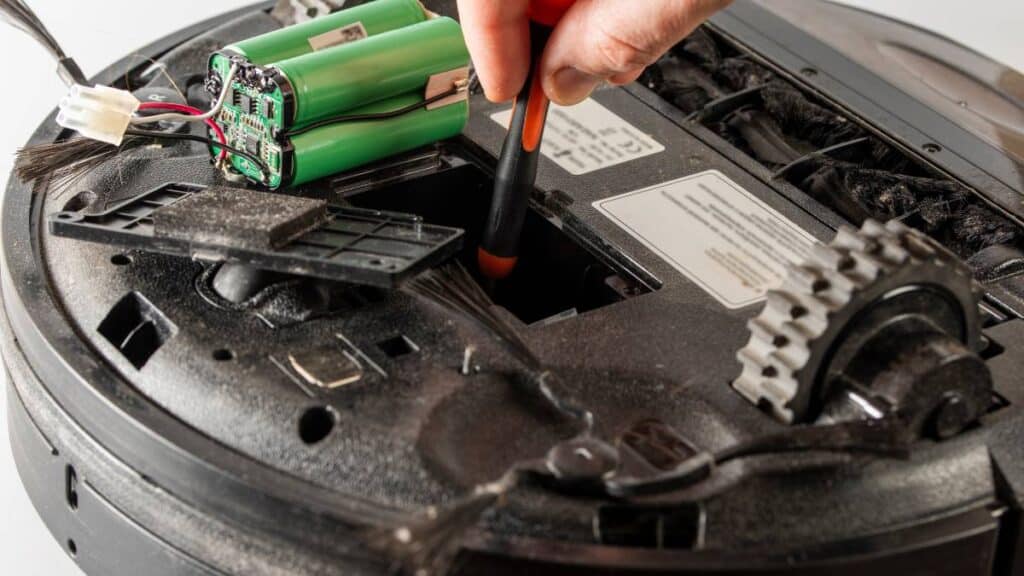
Cordless vacuums rely on battery power to run, making battery life a crucial factor to consider when choosing one. A longer battery life allows you to clean more thoroughly and for more extended periods without needing to recharge. While battery life depends on various factors such as suction power and usage, here’s an approximation of battery life for different types of cordless vacuums:
- Stick vacuums: 20-60 minutes
- Handheld vacuums: 15-30 minutes
- Robotic vacuums: 60-120 minutes
However, battery life is one of many considerations; you also need to evaluate the machine’s charging time. A shorter charging time decreases downtime, allowing you to use the vacuum more regularly. Here’s the average charging time for each type of cordless vacuum:
| Vacuum Cleaner Type | Average Charging Time (in hours) |
| Stick | 3-5 |
| Handheld | 2-4 |
| Robotic | 2-4 |
By evaluating capacity and battery life, you can find a vacuum cleaner that meets your cleaning requirements and preferences.
Enhancing Cleaning Efficiency with the Right Accessories
When it comes to vacuum cleaners, having the right accessories and tools can make all the difference in cleaning efficiency and effectiveness. Whether you need to tackle tough pet hair, tight corners, or delicate surfaces, using the proper attachments can make cleaning a breeze.
Accessories and Tools
Most vacuum cleaners will come with a standard set of attachments, including a crevice tool and a dusting brush. However, there are various specialized tools and accessories available that can expand your vacuum’s capabilities.
Expert Tip: Consider purchasing a powered brush or turbo brush if you have carpets or rugs that require deep cleaning. These attachments use a motorized brush to agitate and remove dirt and debris from fibers, resulting in a more thorough clean.
If you have hardwood or tiled floors, a hard floor attachment can prevent scratches and scuffs while effectively picking up dust and debris. Upholstery tools can be convenient for cleaning furniture and curtains. In contrast, a pet hair tool can help remove pesky pet hair from carpets and upholstery.
Which Attachments to Choose?
The right attachments and brushes can significantly enhance the cleaning capabilities of your vacuum cleaner, and it depends on your cleaning needs and the surfaces you need to clean.
For instance, a motorized brush is ideal for deep-cleaning carpets. At the same time, a crevice tool allows you to reach tight spaces between furniture and walls.
Consider investing in a versatile set of attachments that can handle a range of cleaning tasks, such as:
- Crevice tool – for tight spaces and hard-to-reach areas
- Dusting brush – for gentle cleaning of delicate surfaces and hard-to-reach areas
- Pet hair tool – for removing pet hair from carpets, upholstery, and other surfaces
- Hard floor attachment – for effective cleaning of hardwood, laminate, and tiled floors
- Upholstery tool – for cleaning furniture, curtains, and other upholstery
- Powered brush or turbo brush – for deep cleaning of carpets and rugs
Organizing Your Accessories
Investing in the right attachments is just the first step. For most of your accessories, it’s essential to keep them organized and easily accessible. Consider using a storage bag or caddy to keep your attachments in one place and within reach.
Many vacuum cleaners also come with built-in storage for attachments, so be sure to check your vacuum’s design for this feature. A well-organized set of attachments can make cleaning faster, easier, and more efficient.
Maintaining Your Vacuum Cleaner for Optimal Performance
When investing in a vacuum cleaner, it’s essential to consider not only its features but also its longevity.
As Stefan Bucur, cleaning expert and founder of Rhythm of the Home points out:
“Ideally, a quality vacuum should last for a very long time, think 10 to 20 years. As long as you use it and maintain it properly, you shouldn’t have to buy a new one for the foreseeable future.”
Stefan Bucur
This quote highlights the importance of selecting a durable and reliable vacuum cleaner that can stand the test of time. By choosing a high-quality vacuum and maintaining it according to the manufacturer’s guidelines, you can ensure that your investment will serve you well for many years to come
Regular maintenance is crucial to ensure your vacuum cleaner performs at its best. Here are some essential tips to keep your machine in top shape:
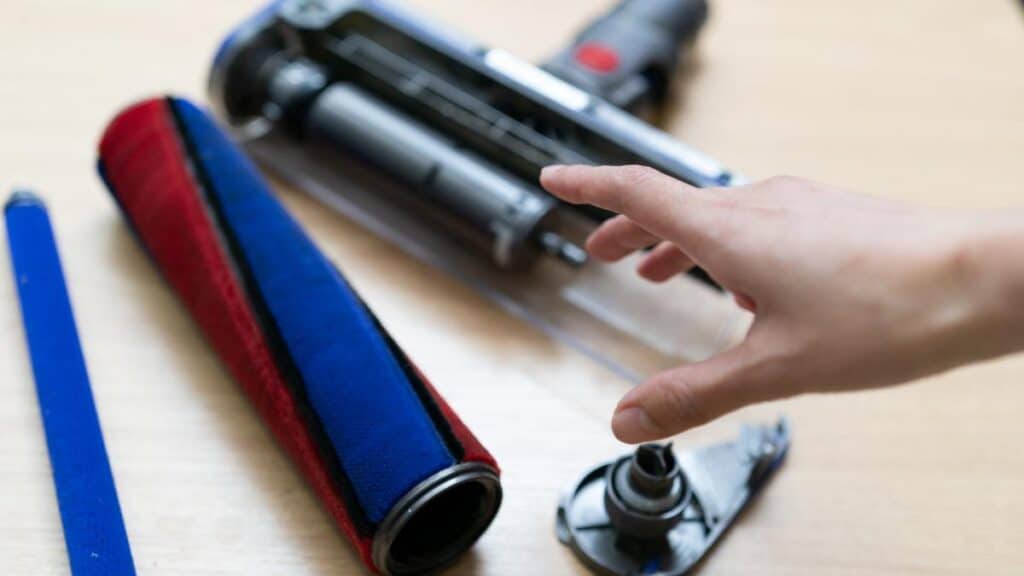
Keep it Clean
Regular cleaning of your vacuum cleaner is essential to keep it functioning efficiently. Make sure to clean the dustbin, filters, and brushes regularly. Depending on your vacuum cleaner, here are some recommendations:
| Vacuum Cleaner Type | Maintenance Tips |
| Bagged Vacuum Cleaner | Replace the bag when it’s 2/3 full. Clean the nozzle and brush roll regularly. Change or clean the filters every few months. |
| Bagless Vacuum Cleaner | Empty the dustbin regularly, ideally when it’s half full. Clean the nozzle and brush roll regularly. Change or clean the filters every few months. |
Check the Filters
Filters are crucial to ensure your vacuum cleaner works efficiently. If they’re dirty or clogged, suction is reduced, compromising the performance. Here are some tips:
- Check and clean the filters regularly according to the manufacturer’s instructions. Some filters are washable, while others require replacement.
- Consider replacing the filters every six months to a year, depending on use.
- If you have allergies, consider investing in a vacuum cleaner with a HEPA filter to remove allergens from the air.
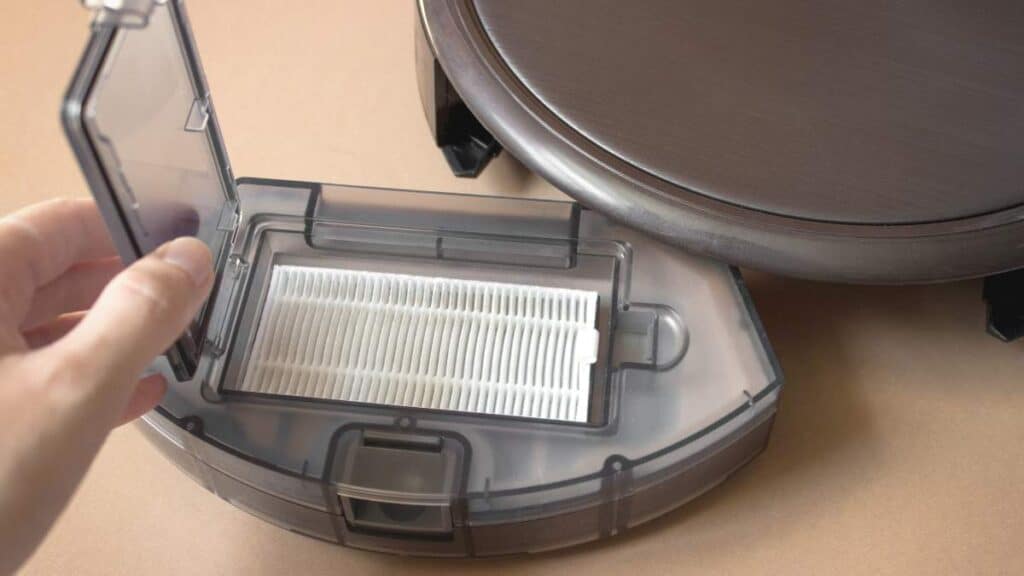
Clean the Brushes
Clean brushes ensure that your vacuum cleaner works at its best. Here are some tips:
- Remove hair and debris from the brush roll regularly to prevent damage.
- For stubborn debris, use scissors or a brush to remove buildup.
- Replace the brush roll if it’s worn or damaged.
Adjust Suction Control
Adjusting the suction control on your vacuum cleaner can help you clean different surfaces effectively. Here’s what you need to know:
- Low suction is suitable for delicate surfaces such as curtains and upholstery.
- High suction is ideal for deep cleaning carpets and removing pet hair.
- Consider investing in a vacuum cleaner with adjustable suction to tackle different surfaces effectively.
Wrap Up:
Regular maintenance of your vacuum cleaner is essential to keep it in good condition and ensure optimal performance. Follow the manufacturer’s instructions, clean the filters and brushes, and adjust the suction control as needed. By doing so, your vacuum cleaner will perform at its best for years to come.
Finding the Perfect Vacuum Cleaner for Your Specific Needs
In your quest to find the perfect vacuum cleaner, it’s crucial to consider your specific needs and circumstances. As Todd Manegold, the general manager of North America at Tineco aptly puts it:
“A person who lives alone in a studio apartment with hardwood floors will likely have very different needs than a family of four with two dogs who live in a two-story home with carpet.”
Todd Manegold
This quote underscores the importance of tailoring your vacuum cleaner choice to your unique living situation and cleaning requirements. Whether you’re dealing with pet hair, a variety of floor types, or a large living space, understanding your specific needs can guide you toward the vacuum cleaner that’s just right for you.
Here are some of the best vacuum cleaners for different environments:
| Vacuum Cleaner Type | Recommended for |
| Upright | Carpets |
| Canister | Hardwood floors and tiles |
| Stick | Small homes and apartments |
| Handheld | Quick cleanups and hard-to-reach areas |
| Robotic | Preventing pet hair buildup and maintenance cleaning |
If you have allergies or pets at home, consider a vacuum cleaner with a HEPA filter to trap allergens and a powered brush attachment to effectively remove pet hair from carpets and upholstery. For stairs and edges, a vacuum cleaner with a crevice tool and turbo brush attachment can reach tight spaces and remove dust and debris.
Large homes may require a vacuum cleaner with a longer cord or high battery life for uninterrupted cleaning. On the other hand, a lightweight and portable vacuum cleaner may be more suitable for tiny homes and apartments where storage space is limited.
Ultimately, the best vacuum cleaner for you depends on your specific cleaning needs and preferences. Consider the factors that matter most to you before making your purchase.
Choosing a Vacuum Cleaner that Fits Your Lifestyle
When it comes to buying a vacuum cleaner, it’s essential to consider the weight and portability of the machine. Depending on your cleaning needs, you may prefer a lightweight, portable, or compact model.
If you have a small apartment or limited storage space, a compact vacuum cleaner can be the perfect fit. These models are lightweight and easy to store, making them ideal for people who want a machine that doesn’t take up too much space.
On the other hand, if you have a large home or want to clean multiple floors, a portable vacuum cleaner can be a better option. These models are designed to be carried around. They can be easily transported up and down stairs, allowing you to clean every corner of your house effectively.
Lightweight Vacuum Cleaners
Lightweight vacuum cleaners are designed to be easy to use and maneuver around your home. They typically weigh less than 10 pounds and are ideal for people who have mobility issues or want a machine that won’t strain their muscles during cleaning.
Some of the benefits of lightweight vacuum cleaners include:
- Easy to carry upstairs and downstairs
- Easy to store in small spaces
- Less physically demanding to use
However, lightweight vacuum cleaners may have different suction power than larger models, so they may not be as effective at cleaning carpets and upholstery. They also tend to have smaller dustbins, which means you may need to empty them more frequently during cleaning sessions.
Portable Vacuum Cleaners
Portable vacuum cleaners are designed for people who want a machine that can be easily transported around their home. These models typically weigh between 10 and 20 pounds and come with wheels, allowing you to move them from room to room without having to carry them.
Some of the benefits of portable vacuum cleaners include:
- Powerful suction for cleaning carpets and upholstery
- Large dustbins, which means you can clean for more extended periods without needing to stop and empty the bin
- Versatile attachments for cleaning different surfaces and hard-to-reach areas
However, portable vacuum cleaners can be more challenging to store than lightweight models, and the extra weight can make them more tiring to use for extended periods.
Compact Vacuum Cleaners
Compact vacuum cleaners are designed to be small and easy to store in tight spaces. These models typically weigh between 4 and 6 pounds and are ideal for people who have small apartments or limited storage space.
Some of the benefits of compact vacuum cleaners include:
- Easy to store in small spaces, such as closets or under the bed
- Less visually intrusive in your home
- It can be great for cleaning hard floors, such as tiles or hardwood
However, compact vacuum cleaners may not have the same suction power as larger models, and they may not be as effective at cleaning carpets or upholstery. They also tend to have smaller dustbins and shorter cords, which means you may need to empty them more frequently and move them around more to clean larger rooms.
Finding a Quiet Cleaning Companion
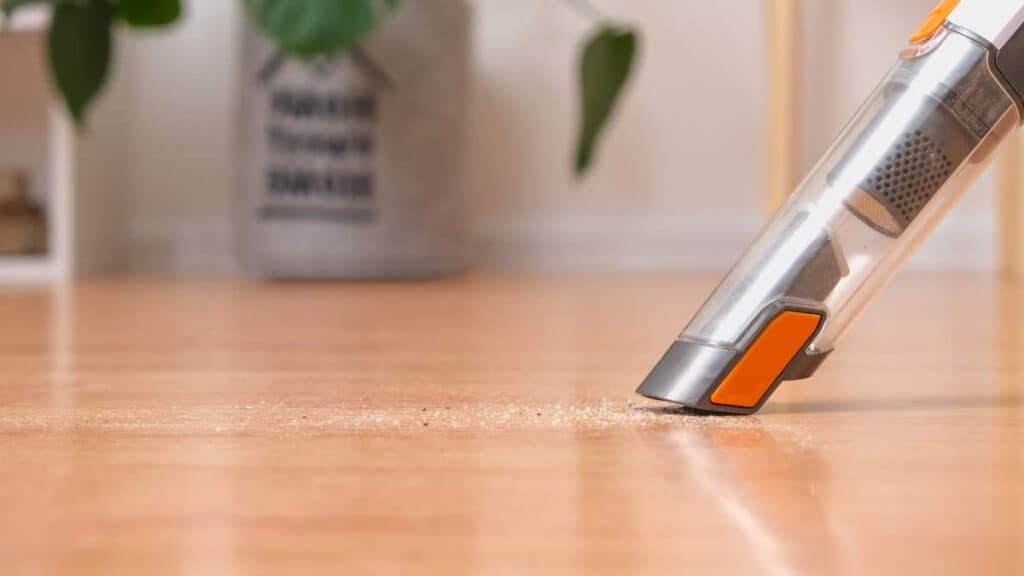
When shopping for a vacuum cleaner, noise level can be a crucial consideration, especially if you live in an apartment or have children or pets that are sensitive to loud sounds. Vacuum cleaners can produce varying levels of noise, measured in decibels (dB), with some models reaching up to 80 dB or more, which is comparable to a garbage disposal or a blender.
If you’re looking for a quiet cleaning companion, consider models that operate at around 70 dB or lower. Some manufacturers provide noise level information in their product specifications, making it easier to compare different models. However, keep in mind that noise levels can vary depending on the surface being cleaned, the type of brush roll used, and the level of suction power selected, among other factors.
To further reduce noise levels, you can opt for models with extra insulation or noise reduction features, such as foam padding or soundproofing materials. Some models also come with settings for quieter operation, such as “silent mode” or “low power mode,” which can be helpful when cleaning during off-hours or in noise-sensitive environments.
Choosing a vacuum cleaner with a lower decibel rating can help minimize noise pollution, making your cleaning experience more enjoyable and less disruptive. Look for models with noise level information provided in the specifications, and consider additional features that can further reduce noise levels.
Choosing the Right Vacuum Cleaner for Different Environments
When it comes to vacuuming, different environments pose unique challenges that require specific cleaning solutions. Below are some tips on choosing the right vacuum cleaner for different scenarios.
Vacuuming Stairs and Furniture
Cleaning stairs and furniture requires a lightweight and portable vacuum cleaner that can be easily maneuvered. Stick and handheld models are ideal options for these scenarios, as they are compact and easy to carry up and down stairs.
Vacuuming Edges and Tight Spaces
For cleaning edges and tight spaces, such as between furniture or along baseboards, a vacuum cleaner with a crevice tool attachment is essential. Canister and stick models typically offer this accessory and provide more flexibility and precision in cleaning hard-to-reach areas.
Cleaning Under Appliances and Furniture
Cleaning under appliances and furniture requires a vacuum cleaner with a low-profile cleaning head and a long wand or hose attachment. Canister and upright models with a detachable hose or wand are excellent options for reaching under tight spaces and furniture with ease.
Vacuuming Large Homes
For large homes, you will need a vacuum cleaner with a long power cord or cordless if you prefer more flexibility. Upright and canister models are the best choices for large homes, as they offer powerful suction and come with multiple attachments for cleaning different surfaces.
Vacuuming Small Homes or Apartments
In tiny homes or apartments, a lightweight and compact vacuum cleaner is ideal, as it is easier to store and maneuver in tight spaces. Stick and handheld models are excellent options for these scenarios, as they take up less space and are easier to handle.
By considering your specific cleaning needs and the different environments you will be cleaning, you can choose the right vacuum cleaner to meet your requirements.
Exploring Trusted Vacuum Cleaner Brands
When it comes to investing in a vacuum cleaner, choosing a reputable brand can provide peace of mind, knowing that you are getting a reliable and durable product. Here are some of the top vacuum cleaner brands with a reputation for producing high-quality models:
| Brand | Reputation | Warranty |
| Dyson | Known for innovative designs and powerful suction | 5-7-year warranty depending on the model |
| Shark | Popular for versatile and affordable models | 1-7-year warranty depending on the model |
| Miele | Respected for exceptional cleaning performance and durability | 1-5-year warranty depending on the model |
| Hoover | Known for producing reliable and feature-packed models | 1-5-year warranty depending on the model |
| Bissell | Popular for producing affordable and easy-to-use models | 1-5 year warranty depending on the model |
While these brands are well-respected, it’s essential to do your own research and read reviews from other customers before making a final buying decision. Additionally, pay attention to the warranty offered by each brand to ensure that you have the proper coverage in case something goes wrong with your vacuum cleaner.
Comparing and Reviewing Top Vacuum Cleaner Models
Choosing the right vacuum cleaner can be a daunting task, with so many brands and models available in the market. That’s why it’s crucial to read consumer reports, expert reviews, and user feedback to make an informed decision.
Before making a purchase, it’s essential to compare different vacuum cleaner models based on factors such as suction power, filtration, and versatility. Consider your cleaning needs and preferences, such as the size of your home and the type of flooring you have.
To make your search easier, we’ve rounded up some of the top vacuum cleaner models in various categories based on expert reviews and user feedback.
Upright Vacuum Cleaners
The Shark Navigator Lift-Away Professional is an excellent choice for those looking for an upright vacuum cleaner with powerful suction. It comes with a detachable canister for easy cleaning of stairs, furniture, and hard-to-reach areas. The HEPA filter ensures that it captures 99.9% of dust and allergens, making it an ideal choice for allergy sufferers.
Another highly rated upright vacuum cleaner is the Dyson Ball Animal 2. It has powerful suction and comes with a self-adjusting cleaner head that automatically adjusts to different floor types. Its whole-machine HEPA filtration keeps allergens at bay, making it an ideal choice for pet owners.
Canister Vacuum Cleaners
The Miele Complete C3 Marin is a top-performing canister vacuum cleaner that comes with six different suction settings for cleaning various surfaces. Its HEPA filter captures 99.9% of allergens, and its powerful suction and sturdy construction make it a suitable option for cleaning large areas.
If you’re looking for a budget-friendly canister vacuum cleaner, the Eureka Mighty Mite is an excellent option. It’s lightweight, compact, and easy to maneuver, making it an ideal choice for cleaning hard-to-reach areas. The machine also comes with multiple attachments, including a crevice tool, upholstery nozzle, and dusting brush.
Stick Vacuum Cleaners
The Dyson V11 Absolute is a top-rated cordless stick vacuum cleaner that comes with a powerful motor and up to 60 minutes of runtime. Its LCD screen shows you the performance of the machine, and its HEPA filter captures 99.97% of dust and allergens as small as 0.3 microns.
The Shark Rocket Corded Bagless Stick Vacuum is an impressive stick vacuum cleaner for those looking for a budget-friendly option. It’s lightweight, has a powerful motor, and comes with a crevice tool and dusting brush. Its swivel steering allows for easy maneuverability, making it an ideal choice for cleaning tight spaces.
Robotic Vacuum Cleaners
The iRobot Roomba i7+ is a top-rated robotic vacuum cleaner that offers powerful suction and automatic dirt disposal. Its HEPA filter captures 99% of allergens, making it an ideal choice for allergy sufferers. The robotic cleaner maps your home and creates cleaning routes, making it an efficient choice for cleaning large areas.
Another highly recommended robotic vacuum cleaner is the Ecovacs Deebot N79S. It offers excellent cleaning performance on hardwood floors and carpets. It comes with a smartphone app for easy scheduling and operation. The machine also has an auto-recharge function and can return to its charging dock when its battery runs low.
By comparing and reviewing top vacuum cleaner models, you can find the suitable machine that meets your cleaning requirements and enhances your overall cleaning experience.
Conclusion
Choosing the right vacuum cleaner can be a daunting task. Still, armed with knowledge of the different types, features, and accessories, you can make an informed decision that suits your cleaning needs and preferences.
Bagged or bagless? Corded or cordless? Upright or canister?
These are just a few of the questions you need to ask yourself before making a decision. Take into account your space, surfaces, pets, allergies, and cleaning habits to ensure you get the best cleaning companion for you.
Remember to consider the suction power, filtration, and attachments of a vacuum cleaner. The right combination of these features can make a massive difference in the effectiveness of your cleaning routine. Additionally, keep the maintenance of your vacuum cleaner in mind to maximize its lifespan and performance.
When choosing a vacuum cleaner, brand reputation, reliability, and warranty coverage are also important factors to consider. A trusted brand with favorable customer feedback can give you peace of mind in your purchase.
Remember to enhance your cleaning efficiency with the right accessories, such as powered brushes, crevice tools, and turbo brushes. These tools can help you tackle different cleaning challenges and surfaces with ease.
FAQ
What are the different types of vacuum cleaners available?
The main types of vacuum cleaners available today include upright, canister, stick, handheld, and robotic models. Upright vacuums are full-sized with the motor and dust bin directly attached to the cleaning head. Canister vacuums have the motor and bin in a separate wheeled unit that connects to a cleaning head via a hose. Stick vacuums are lightweight and designed for quick jobs. Handheld vacuums are compact for small cleanups. Robot vacuums are self-propelled and automated.
How do bagged and bagless vacuum cleaners differ?
Bagged vacuums collect dirt in disposable bags that must be replaced periodically. Bagless vacuums collect dirt in a removable dust cup that can be emptied and reused. Bagless models avoid the recurring cost of bags, but bagged models generally have better filtration.
What are the pros and cons of corded and cordless vacuum cleaners?
Corded vacuums offer continuous power but have a limited range. Cordless vacuums provide freedom of movement but may have shorter runtimes and longer recharge times. Corded models also tend to have greater suction power.
What features should I consider when choosing a vacuum cleaner?
Key factors include suction power, filtration system, attachments, brush type, maneuverability, capacity, noise level, weight, cordless or corded, and any special features for your needs. Consider your home size, flooring types, and whether you have pets.
How can I maintain my vacuum cleaner for optimal performance?
Regularly clean or replace filters, brushes, and belts per manufacturer instructions. Adjust suction for different surfaces, empty bin/replace bags when full, and detach and clean attachments. Avoid vacuuming up liquids or large debris.
Are there quiet vacuum cleaner models available?
Yes, some vacuums are designed for quieter operation, usually at higher price points. Features like sound insulation, brush-roll shutoff, and quieter motors can reduce noise without sacrificing suction power.
What factors should guide my vacuum cleaner choice for my lifestyle?
Consider your flooring, traffic levels, storage space, cord preferences, pets, allergies, ease of use needs, and cleaning challenges. Your lifestyle will determine what features and attributes are most important.
How do capacity and battery life impact vacuum cleaner efficiency?
Higher capacity equals fewer stops to empty dirt. Longer battery life enables cleaning large areas on one charge. Insufficient capacity or battery life reduces cleaning efficiency and convenience.
Are vacuums designed for specific surfaces like hardwood or tile?
Yes, some vacuums are tailored for hard floors, low-pile carpets, or high-pile carpets. Models with adjustable suction, brushrolls, and soft bristles are ideal for delicate surfaces. Check manufacturer guidelines.
Which brands have the best reputation for reliable, durable vacuum cleaners?
Top brands known for quality and reliability include Miele, SEBO, Lindhaus, Simplicity, Riccar, and some higher-end models from Hoover, Kenmore, Bissell, Shark, Dyson, and Eureka, among others.
How can I effectively compare different vacuum cleaner models?
Consulting expert reviews, consumer reports, and user feedback help compare suction, features, reliability, and real-world performance. Testing vacuums yourself at the store can also inform your decision.
What accessories can improve the efficiency of my vacuum cleaner?
Helpful accessories include powered brushrolls, crevice tools, pet hair attachments, extension wands, specialty brushes, and filters. They allow you to tailor your vacuum to specific cleaning needs.
Are vacuums designed specifically for stairs, furniture, and hard-to-reach areas?
Yes, some vacuums excel at cleaning stairs, furniture, edges, and hard-to-reach spots under appliances. Features like extension hoses, crevice tools, and adjustable power nozzles optimize these capabilities.
What factors should I consider when choosing a vacuum for different home sizes?
For large homes, prioritize power, capacity, and cord length. For apartments, focus on storage size and weight. Match the vacuum’s capabilities to the size and challenges of the specific environment.
What are the key takeaways for choosing the best vacuum cleaner?
Focus on your flooring, cleaning needs, and lifestyle. Research top brands and models. Compare features, performance, and reliability. Test vacuums in person when possible. Invest in quality. Follow maintenance guidelines.


